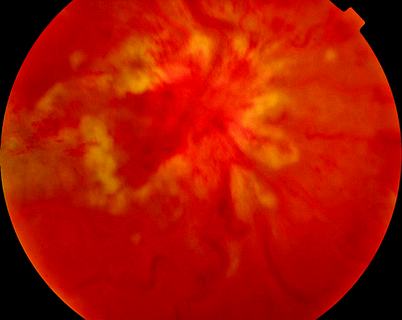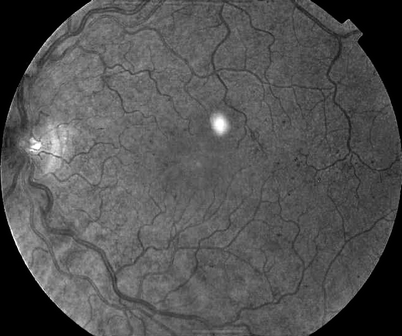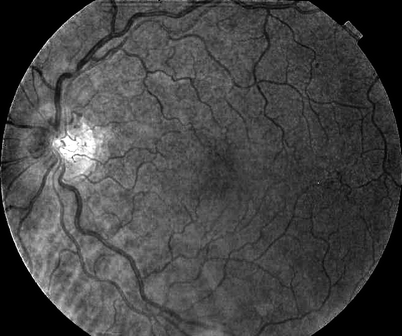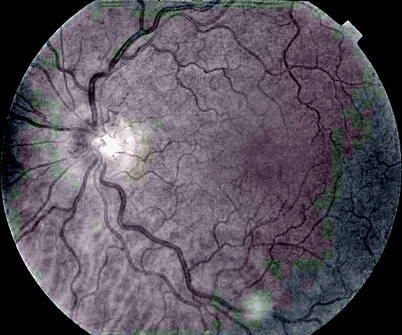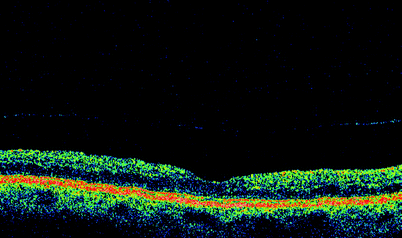(1)
Department of Ophthalmology, St. Thomas’ Hospital, London, UK
13.1 Introduction
13.2.1 Chorioretinal Anastomosis
13.2.2 Arteriovenous Decompression
13.2.3 Radial Optic Neurotomy
13.2.5 Tissue Plasminogen Activator
13.3 Sickle-Cell Disease
13.3.1 Introduction
13.3.2 Types of Sickle-Cell Disease
13.3.3 Systemic Investigation
13.3.4 Inheritance and Race
13.3.5 Systemic Manifestations
13.3.6 Ophthalmic Presentation
13.3.7 Laser Therapy
13.3.8 Surgery
13.3.9 Visual Outcome
13.3.10 Screening
13.3.11 Survival
13.4 Retinal Vasculitis
13.6 Summary
Abstract
There are a number of conditions which stimulate neovascularisation of the retina with subsequent complications such as vitreous haemorrhage and tractional retinal detachment from pathological separation of the vitreous. The most common is severe diabetic retinopathy but also retinal vein occlusion, sickle-cell retinopathy and retinal vasculitis.
Electronic supplementary material
The online version of this chapter (doi:10.1007/978-3-642-31872-6_13) contains supplementary material, which is available to authorized users.
13.1 Introduction
There are a number of conditions which stimulate neovascularisation of the retina with subsequent complications such as vitreous haemorrhage and tractional retinal detachment from pathological separation of the vitreous. The most common is severe diabetic retinopathy but also retinal vein occlusion, sickle-cell retinopathy and retinal vasculitis.
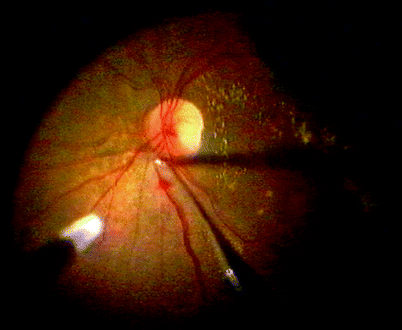

Fig. 13.1
It is possible to dissect the overlying artery off the underlying occluded retinal vein in a branch retinal vein occlusion to try to relieve the blockage
13.2 Retinal Vein Occlusion
Retinal vein occlusions (RVO) are the second commonest vascular events in the eye after diabetic retinopathy. The eye is unusual in suffering from occlusion of the veins more often than arteries. Retinal vein occlusion can be divided into two groups, branch retinal vein occlusion, BRVO, and central retinal vein occlusion, CRVO (which includes hemiretinal vein occlusion). BRVO occurs most commonly where a retinal arteriole crosses over a venule. Sharing an adventitial sheath in the presence of the thickened arteriolar wall may compress the thinner walled venule resulting in occlusion. In CRVO, pathological evidence suggests the site of obstruction is situated at the lamina cribrosa (Green et al. 1981). A number of innovations have been designed, but none are of proven benefit.
New methods:
Chorioretinal anastomosis | CRVO |
Intravitreal steroid injection | CRVO and BRVO |
Pars plana vitrectomy | CRVO and BRVO |
Arteriovenous decompression | BRVO |
Radial optic neurotomy | CRVO |
Tissue plasminogen activator | CRVO |
13.2.1 Chorioretinal Anastomosis
Chorioretinal anastomosis using argon laser has been successful improving vision in one-third of eyes in the non-ischemic variant of the disorder in selected patients but has been associated with frequent complications (Browning and Antoszyk 1998; McAllister et al. 1998; McAllister and Constable 1995). This therapy is not generally used in ischemic CRVO because of a high complication rate in particular neovascularisation.
13.2.2 Arteriovenous Decompression
Table 13.1
Difficulty rating for arteriovenous decompression
Difficulty rating | High |
Success rates | Unknown |
Complication rates | Low |
When to use in training | Late |
Grid macular laser therapy in BRVO can control macular oedema, with 60 % of treated cases retaining 20/40 vision or better at 3 years (Branch Vein Occlusion Study Group 1984) and reduce the incidence of vitreous haemorrhage by half (Branch Vein Occlusion Study Group 1984, 1986). In BRVO, the site of occlusion can easily be visualised and is thought to occur as a result of arteriosclerosis in the media of the artery giving rise to a compressive effect on the adjacent vein. At the arteriovenous crossing, the artery is generally located anterior to the occluded vein, within a common adventitial sheath. Charles attempted to relieve the blockage by dissecting the arteriole off the venule at the arteriovenous crossing in one patient (Osterloh and Charles 1988). Recently, the technique has been revisited with reported success in 10 out of 15 patients, with an average gain of four lines of vision (Opremcak and Bruce 1999). In a non-randomised comparative study, patients receiving intervention performed better with 75 % doubling their visual angles compared to 40 % with conventional treatment (Mason et al. 2004). Opremcak has designed an instrument for the blunt dissection of the arteriole from the venule by inserting a spatulated knife between the blood vessels. Potential complications include retinal tear or detachment, vitreous haemorrhage, retinal gliosis at the incision site, arcuate scotoma and cataract. Resolution of macular oedema following sheathotomy has been confirmed using optical coherence tomography (OCT) (Fujii et al. 2003). There are also theoretical reasons whereby the localised ischemia of the retina in BRVO might be improved by the PPV procedure because removal of the vitreous gel may allow oxygenation of the retina from other sites in the eye with good blood flow (Cringle et al. 1992). Indeed, some investigators have tried PPV and gas alone (Saika et al. 2001).
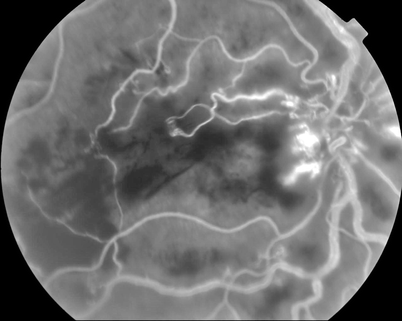
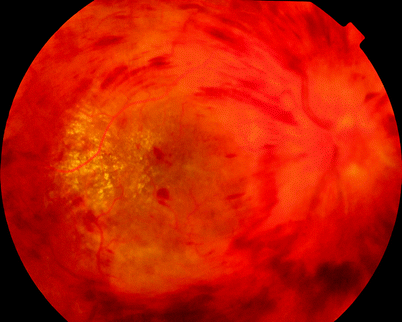

Fig. 13.3
See previous figure

Fig. 13.4
A 13-year-old girl with CRVO in whom the onset was associated with a bout of diarrhoea on ski trip and a short-haul plane journey. She had a familial cholesterolaemia
13.2.3 Radial Optic Neurotomy
Table 13.2
Difficulty rating for RON
Difficulty rating | Low |
Success rates | Unknown |
Complication rates | Low |
When to use in training | Late |
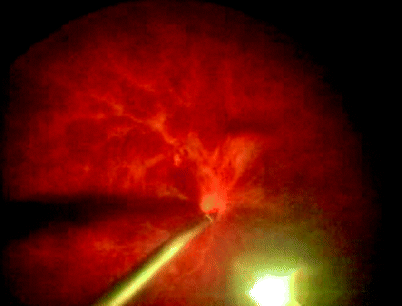
Fig. 13.5
Incising the optic nerve in radial optic neurotomy is of uncertain worth in the treatment of central retinal vein occlusion
Usually, CRVO is associated with severe irreversible visual loss and with improvement of vision in only 20 % (The Central Vein Occlusion Study Group 1997). Incision of the optic nerve on the nasal side (radial optic neurotomy) has been described (Opremcak et al. 2001; Williamson et al. 2003; Garcia-Arumi et al. 2003) but is of unproven benefit as yet despite large case series (Opremcak et al. 2001, 2006). It is thought that the neurotomy may help blood flow in the central retinal vein by relieving pressure on the vein as it exits the lamina cribrosa, assuming that CRVO is a ‘neurovascular compression syndrome’, resulting from increased pressure within the confined space of the scleral outlet. Intravitreal pO2 is severely reduced in CRVO and may be increased by vitrectomy (Williamson et al. 2009a).
13.2.4 Intravitreal Steroid and Anti-VEGF Agents
Table 13.3
Difficulty rating for intravitreal steroid injection
Difficulty rating | Low |
Success rates | Slight |
Complication rates | Low |
When to use in training | Early |

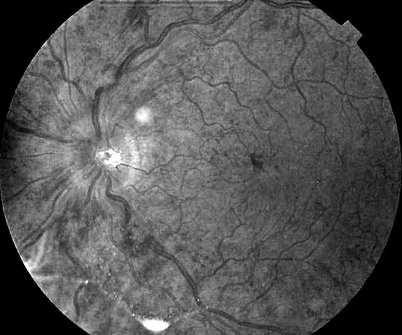
Fig. 13.7
See previous figure
Cystoid macular oedema (CMO) is a major cause of visual loss in RVO. Injections of varying doses of triamcinolone into the vitreous cavity (1–21 mg) have been investigated for reversing CMO in uveitis, postcataract surgery, retinal vein occlusion, telangiectasia and diabetes (Jonas et al. 2002, 2003, 2004, 2005a, b; Spandau et al. 2005; Alldredge and Garretson 2003; Antcliff et al. 2001; Benhamou et al. 2003; Bynoe and Weiss 2003; Conway et al. 2003; Martidis et al. 2001; Greenberg et al. 2002; Martidis et al. 2002; Degenring and Jonas 2003; Degenring et al. 2003; Williamson and O’Donnell 2005). Dexamethasone pellets can be inserted into the vitreous and have shown some efficacy for improved vision over 6 and 12 months (Haller et al. 2010), but as with triamcinolone, repeated injections are required.
The steroid stabilises the leaky vascular endothelium reducing the extracellular fluid accumulation perhaps by downregulating vascular endothelial growth factor (VEGF) (Jonas and Sofker 2001). In many cases, the feasibility of steroid is lessened because the duration of action is only a few months, requiring the administration of repeated injections in chronic conditions. Unfortunately, those repeat injections are associated with a reduced or absent response with time (Williamson and O’Donnell 2005). Dexamethasone has, however, been associated with less frequent IOP elevation than triamcinolone injection which in the later can be severe and require surgery for IOP control.
Anti-VEGF agents have been used widely for cystoid macular oedema from many causes including RVO. Bevacizumab reduces CMO and improves vision with low complication rates but requires repeat injection. Anti-VEGF agents are useful also for controlling neovascular glaucoma.
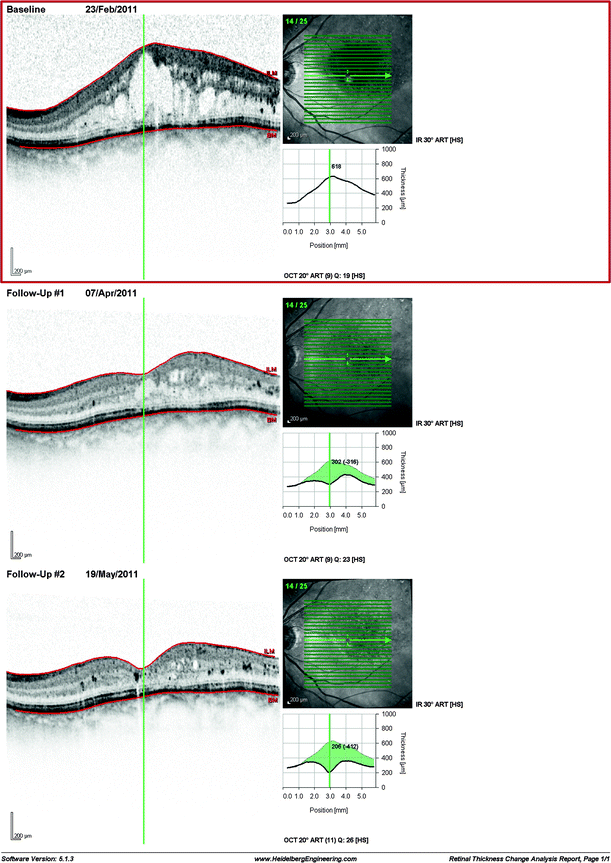
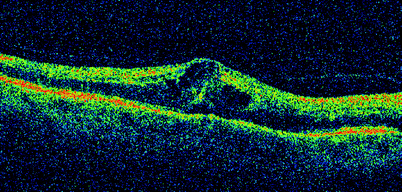
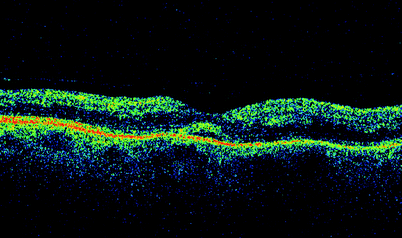


Fig. 13.13
CMO of the retina from BRVO, reduced by the intravitreal injection of bevacizumab

Fig. 13.14
CMO from CRVO can be treated by Avastin as in this patient; however, it does not aid recanalisation of the vein, and these patients may suffer later loss of vision even without return of the CMO. Notice how in this sequence of OCT the vitreous can be seen to separate a common accompaniment to acute retinal ischaemia (see Figs. 13.15– 13.16)

Fig. 13.15
See previous figure

Fig. 13.17
Iris neovascularisation after CRVO. The neovascularisation can be reversed by injection of anti-VEGF into the vitreous. This may temporarily reduce the IOP to allow PRP or other measures such as PPV in an attempt to reverse the ischaemia. Repeated injections can be used to prolong the duration of residual vision in the eye (for up to 2 years), although these patients will usually eventually suffer further loss of vision from retinal ischaemia and CMO
13.2.5 Tissue Plasminogen Activator
TPA may not cross the vasculature to enter the central retinal vein; therefore, investigators have attempted to insert TPA directly into the vein (Weiss 1998) using a 33-G cannula. The technique does not seem to have had a major effect on visual acuity, and vitreous haemorrhage is common (Weiss and Bynoe 2001). More recently, Weiss has added intravitreal steroid injections to try to improve success rates (Bynoe and Weiss 2003).
13.3 Sickle-Cell Disease
13.3.1 Introduction
The sickle-cell haemoglobinopathies result from an abnormality in the beta chain of the haemoglobin molecule. They are hereditary disorders that cause red blood cells to take on a sickle shape. These blood cells are rigid and pass with more difficulty through blood vessels causing vascular occlusion in multiple organs including the retina. There are chronic haemolytic anaemia and vaso-occlusive crises and a number of clinical features in the eye (Clarkson 1992). Sickling occurs more in hypoxic or acidotic conditions.
Stay updated, free articles. Join our Telegram channel

Full access? Get Clinical Tree


